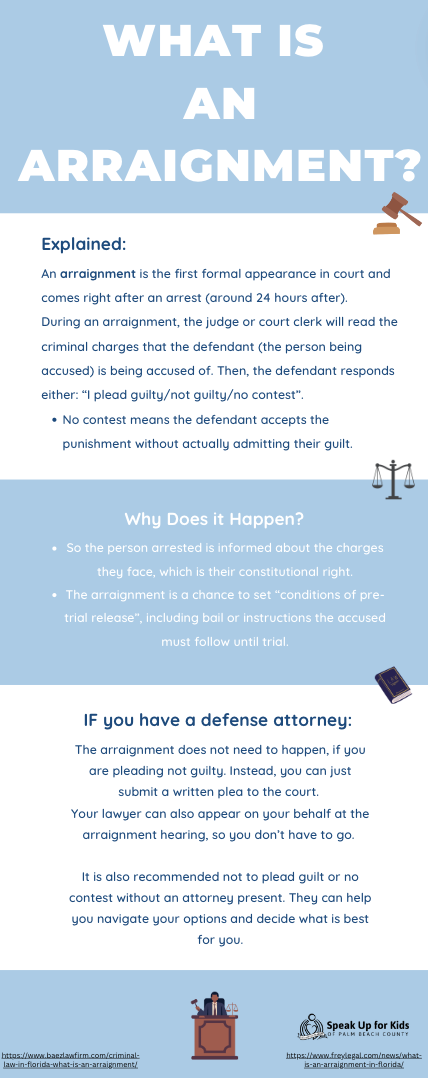Legal Series- What is an Arraignment
An arraignment is a formal court proceeding that takes place after a person has been arrested and charged with a crime. It is an essential part of the criminal justice process where the defendant is formally informed of the charges against them and given an opportunity to enter a plea. Understanding what happens during an arraignment and what to expect can help you navigate this critical step in the legal process. Here’s a guide on what an arraignment involves and how it affects your case.
Steps:
Preparation for the Arraignment:
Legal Representation: It is crucial to have legal representation during the arraignment. If you cannot afford an attorney, the court will appoint a public defender or you may need to seek private legal counsel.
Review Charges: Before the arraignment, review the charges against you with your attorney. Understanding the nature of the charges and the evidence involved is important for making informed decisions.
The Arraignment Process:
Court Appearance: Attend the arraignment in the appropriate court. This is usually the first court appearance following your arrest and booking.
Reading of Charges: The judge or court clerk will formally read the charges against you. This ensures that you are fully informed of the accusations and evidence.
Entering a Plea:
Plea Options: You will be asked to enter a plea to the charges. Common plea options include:
Guilty: Admitting to the charges and accepting responsibility.
Not Guilty: Denying the charges and requesting a trial.
No Contest (Nolo Contendere): Not contesting the charges, which has the same legal effect as a guilty plea but may not admit guilt explicitly.
Consult with Attorney: Discuss your plea options with your attorney before making a decision. They can advise you on the best course of action based on the specifics of your case.
Bail and Release:
Bail Hearing: The judge may address bail or bond during the arraignment. If you are held in custody, the judge will determine whether you can be released on bail or bond and the conditions of release.
Release Conditions: If released, you may be subject to certain conditions, such as attending future court hearings or refraining from contacting certain individuals.
Setting Future Dates:
Pretrial Motions and Hearings: The court may schedule future dates for pretrial motions, hearings, or trial. These dates will be discussed during the arraignment.
Trial Preparation: If you plead not guilty, the next steps will involve preparing for trial, including gathering evidence, filing motions, and attending additional hearings.
Post-Arraignment Actions:
Legal Strategy: Work with your attorney to develop a legal strategy for your case. This may involve negotiating a plea deal, preparing for trial, or seeking dismissal of charges.
Compliance: Ensure that you comply with any conditions set by the court, including attending all scheduled court appearances and following legal advice.
Key Questions:
What Happens During an Arraignment?
What is the purpose of the arraignment, and what will occur during the proceeding?
Who will be present during the arraignment, and what role does each participant play?
What Are the Plea Options?
What are the potential outcomes of entering a guilty, not guilty, or no contest plea?
How should I decide which plea to enter based on the advice of my attorney?
What About Bail and Release?
How is bail or bond determined, and what factors influence the judge’s decision?
What conditions might be imposed if I am released, and how do I ensure compliance?
What Future Dates Will Be Set?
What future court dates should I expect, and what is their significance?
How will these dates impact the progression of my case?
What Actions Should I Take After the Arraignment?
How can I work with my attorney to develop an effective legal strategy?
What steps should I take to comply with court conditions and prepare for upcoming hearings or trial?
Tips:
Be Prepared: Review the charges and discuss your plea options with your attorney before the arraignment to make informed decisions.
Stay Calm: The arraignment is a formal process, but staying calm and following legal advice will help you navigate it more effectively.
Understand Your Rights: Ensure you understand your rights during the arraignment, including the right to legal representation and the right to remain silent.
Follow Court Orders: Adhere to any conditions or orders given by the court, and attend all scheduled court appearances to avoid additional legal complications.
By following these steps and considering these questions, you can better understand the arraignment process and prepare for this important stage in your legal proceedings. The arraignment is a key opportunity to address charges, enter a plea, and set the course for the future of your case


